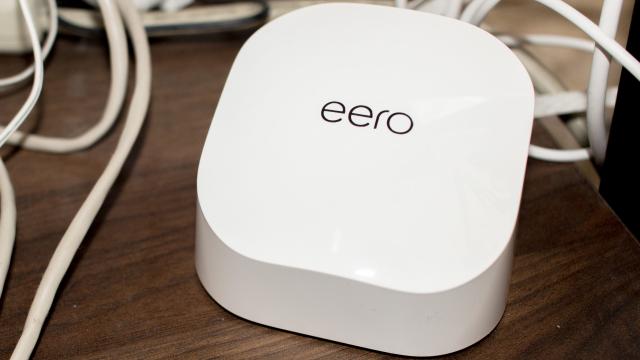Nick Weaver has a dog in the 5G fight.
Weaver’s company, Eero, went from making niche home-networking software to being bought out by Amazon in February 2019. Along the way, his startup became part of Amazon’s constellation of unwired home accessories that depend on Wi-Fi to connect to Amazon services and the Internet.
Eero, which began in 2014 as a mesh-networking startup, was a Silicon Valley darling until other manufacturers, most notably Google, began eating away at the company’s market share. By the time Amazon came along, the bloom was off the rose for mesh network routers, and major players like Linksys and Belkin released their own products to compete. One major mesh network contender, Luma, even shut down in the aftermath.
Eero products are aimed at users with larger homes. By putting an Eero base station on every floor of a palatial estate (or a Brooklyn row house), the network speed and quality increase with each node added. Weaver, for his part, thinks products like Eero are integral in the future of home networking.
He said in-home Wi-Fi is not threatened by 5G networking and that instead, it will grow to fill niches that mobile wireless can’t. He’s careful to offer caveats, however.
“You shouldn’t ever really make a decree about technology. I mean look at early decrees about how popular the mobile phone was going to be or the iPhone,” Weaver told Gizmodo. “How many famous quotes are there where people say you’ll never need more than 250MB of storage?”
[referenced id=”1148588″ url=”https://gizmodo.com.au/2019/02/amazon-eats-eero/” thumb=”https://gizmodo.com.au/wp-content/uploads/2019/02/12/cskzysuhzy4a1bdfzi4d.jpg” title=”Amazon Eats Eero” excerpt=”Up until about a few minutes ago, Eero’s mesh networking system was our recommendation for filling a large home with reliable, fast, and easy to use Wi-Fi. But now that Amazon has just announced it’s acquiring the company, it might not be a bad idea to put your wi-fi upgrade…”]
That said, he doesn’t believe that Wi-Fi will be threatened by 5G in any practical sense. In fact, he thinks they will work together.
“When you look at connectivity, Wi-Fi is the most prolific wireless connectivity in the world,” he said. “There are more devices that connect over Wi-Fi than any other wireless technology.”
“It’s extraordinarily cost-effective,” he said. “So when you look at just the cost to add Wi-Fi to a device, you’re talking like a couple of dollars. For a 5G access point, you’re looking at $US5 ($7) or more per unit, up to maybe $US40 ($52) of the total cost.”

The young CEO’s original goal with Eero was to make mesh networking easier. After using competing products, he found that what consumers really wanted was an IT professional in a little plastic box. Instead of endless lists of features, Eero’s set-it-and-forget-it user experience was a refreshing change. Now that his company is established, he sees the need for better and faster Wi-Fi.
“We’re are going to have increased connectivity needs everywhere,” he said. “And so you’re going to want to compliment your internet connection with 5G or even have 5G as your primary internet connection. In terms of bandwidth but also in terms of a concurrent number of devices, Wi-Fi is going to continue to be the major workhorse to keep all the devices in our home connected.”
5G, in other words, solves the last mile problem while Wi-Fi solves the last metre problem.
“I think 5G is likely going to be predominantly an access technology, meaning it provides internet access to the home,” he said. “And then from there, technologies like Wi-Fi and other low power standards will take over to actually distribute the network access to the tens or hundreds of devices a customer might have.”
[referenced id=”1532095″ url=”https://gizmodo.com.au/2020/11/amazons-eero-6-is-the-cure-for-your-stuck-at-home-internet-problems/” thumb=”https://gizmodo.com.au/wp-content/uploads/2020/11/25/o2vtdkl5o3kaovkkoom3-300×168.jpg” title=”Amazon’s Eero 6 Is the Cure for Your Stuck-At-Home Internet Problems” excerpt=”We’re all trapped at home sharing broadband for the foreseeable future with no end in sight, and our internet setups need some help. You might be looking at mesh routers as a solution to help blanket your house with Wi-Fi and ensure that every Zoom meeting, online class, and virtual…”]
“Imagine taking a $US50 ($65) Fire TV stick and adding in a $US50 ($65) 5G modem built-in,” he said. “I just I don’t think a lot of customers will go for that.”
Ultimately, Weaver expects 5G in the home within 36 months. Although he doesn’t believe in making predictions, he’s pretty excited by the prospect while still backing Wi-Fi.
“I’m bullish on it,” he said. “There’s always going to be a need.”
